 |
||
|
||
| ||
We continue keeping you fully armed with what are the latest video cards on GPU NVIDIA GeForce2 MX which is on the peak of popularity. Note that GeForce2 MX is the most beneficial from a consumer's point of view, though not the most efficient. I have written on the chipset itself not once and have already considered many video cards based on it, that's why I will directly turn to a subject of today's review - AOpen PA256MX Deluxe. The board belong to the mainstream market niche and is mainly intended for tight-budget systems. Such video cards will satisfy the widest circle of gamers and not only them. Besides, the considered card has some peculiar features. BoardJudging by the suffix Deluxe we should assume that there are something that sets the card apart. Well, that's true, but let's talk about it a bit later. The card is equipped with AGP2x/4x interface, 32 MBytes SDR SDRAM from Hyundai located in 4 chips on the right side of PCB. 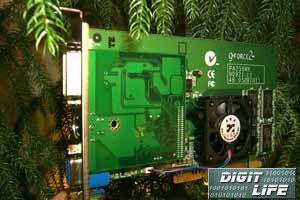 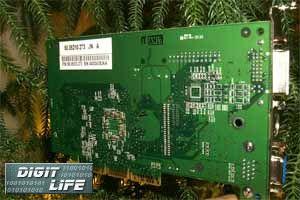 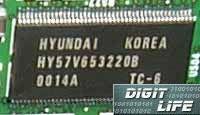 Memory chips are produced by Hyundai and work at 166 MHz. Now let's dive into special features. If you read about Aopen PA25 Deluxe before (video cards on NVIDIA GeForce2 GTS) this card and the considered today one have the same daughter board quite big in size. This is the board where you can find TV-out logic, Hardware Monitoring and OpenBIOS. The idea of the OpenBIOS technology is that the BIOS includes interactive control (that is its own Setup) where you can control both chip and memory frequencies and voltage: 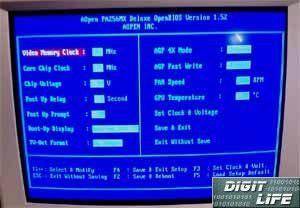 By the way, you can control BIOS settings not only from its Setup but also via a utility OpenGPU from Windows 9x/ME: 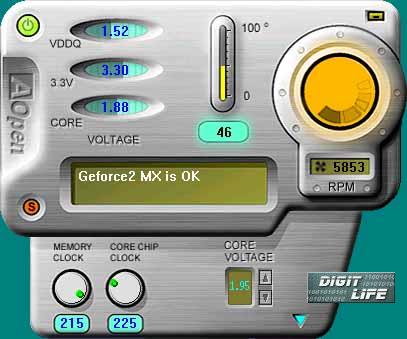 The utility has a stylish design and allows controlling nearly all options of OpenBIOS; it puts all changes directly into a flash-memory and it doesn't change registry key as the majority of utility-"tweakers" do. The utility informs on video card status as well, that is it implements Hardware Monitoring. This technology differs from ASUS SmartDoctor in the fact that it's not importunate service that constantly tries to decrease card's frequency, it just controls heat and voltage. In case of danger you will hear a signal and the program itself will break the current active application and inform of a dangerous status of the video card. The chipset is equipped with an active cooler that has a tachometer. The fan on a cooler is rather effective, therefore you might hope for good overclocking on GPU. The PCB is legacy green. The design completely follows the reference one from NVIDIA (even what concerns OpenBIOS, Hardware Monitoring which is situated on a daughter board). The video card is supplied with a jack for digital monitors (DVI), though it lacks for a S-Video-to-RCA adapter. That's way if your video equipment doesn't have S-Video-connectors you won't be able to use TV-out. The card sells in a box of bright design: 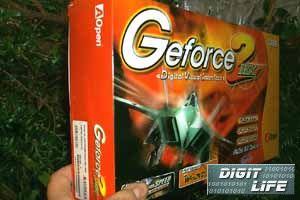 What is in the box:
OverclockingWith this card we managed to overclock the graphics core up to 225 MHz, and the memory worked at 215 MHz. It's nearly a record among all considered video cards of this class! Note that while overclocking we always use an additional fan installed in the case of test-machine. Installation and driversAs usual first comes the testbed:
The card is supplied with drivers from Aopen, version 6.18, based on the NVIDIA reference drivers 6.18. All settings except overclocking (they are in OpenGPU utility) follow reference drivers from NVIDIA. Since there appeared some other versions of drivers from NVIDIA after 6.18, we carried tests on the version 6.47. Note that while testing, Vsync was off. Beside this card, you will see the results for the following video cards: reference card NVIDIA GeForce2 MX, Leadtek WinFast GeForce2 MX DVI, ELSA Gladiac MX. Test results2D-graphics. I have already estimated speed parameters in the first review on the ASUS AGP-V7100 card. All cards based on GeForce2 MX don't practically differ there. As far as 2D-graphics quality is concerned, there is nothing to complain about. The absolute majority will be satisfied with it. The following programs will help us to consider performance in 3D-graphics:
Quake3 ArenaThe test on the standard demo002 was carried out in two modes: Fast (shows card's work in 16-bit color) and High Quality (shows card's work in 32-bit color).  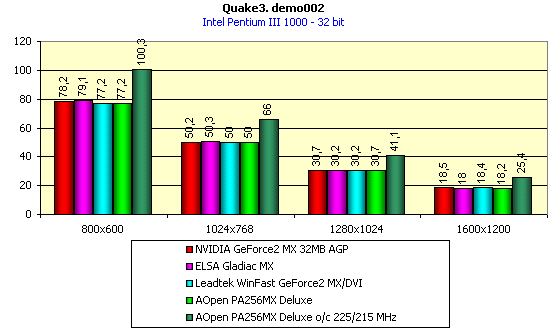 The results were expectable. The card doesn't differ in speed from its rivals. When overclocked the card provides much higher performance, again 95% thanks to memory frequency increase (not chipset frequency). I must repeat again saying that all NVIDIA processor based video cards have a memory bandwidth that unpleasantly limits GPU potential. ExpendableWe will use this game to show the card's speed in Direct3D. 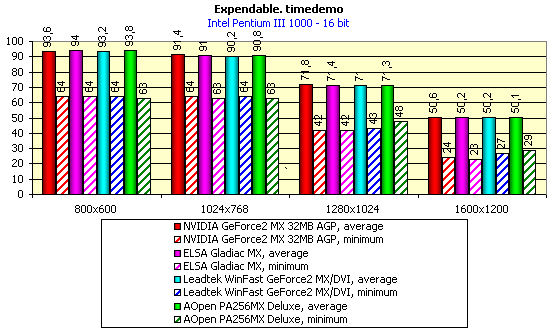  The results shown are identical. AOpen PA256MX Deluxe gives out right the same performance as its analogs. Finishing with the performance of this card I want to stress on the following:
Additional featuresOf cause, many of you are interested in the work of new cards from the point of view of DVD-video support. I have already noticed that NVIDIA GeForce256/GeForce2 chips offer a full support for decoding MPEG2-stream. All modern soft DVD players support these processors, that's why you can easily get a good quality level of video playback together with a low CPU load. The card AOpen PA256MX Deluxe is equipped with WinDVD 2000 player. After optimization of all functions under NVIDIA GeForce2 the image on NVIDIA GeForce2 MX was very good. And the processor's load constituted only 26-29% ! ConclusionAOpen company granted us again a perfect product of its class. I have already mentioned that AOpen products have always something unusual in order to surprise us; besides, they completely follow the reference specification. The considered video card provides us with parameters not worse (in performance and quality) than the reference card from NVIDIA. Plus a bright feature in the form of OpenBIOS. This technology includes also the Hardware Monitoring. It's not a secret that most of you would like to overclock GeForce2 MX based video cards. And this technology allows controlling the process and prevents any damage. Highs:
Lows:
Write a comment below. No registration needed!
|
Platform · Video · Multimedia · Mobile · Other || About us & Privacy policy · Twitter · Facebook Copyright © Byrds Research & Publishing, Ltd., 1997–2011. All rights reserved. |